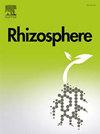Effect of rhizosphere soil microenvironment interaction on ginsenoside content in Panax ginseng: A case study of three-year-old agricultural ginseng
IF 3.4
3区 生物学
Q1 PLANT SCIENCES
引用次数: 0
Abstract
Planting ginseng (Panax ginseng C. A. Meyer) in farmland is the main method of ginseng cultivation, but the interaction between the rhizosphere soil microenvironment and the mechanism of ginsenoside accumulation in ginseng roots are still unclear. Therefore, the content of ginsenoside and rhizosphere soil microenvironment of 3-year-old agricultural ginseng at two growth periods (May and October) were studied. The results showed that the content of bulk density, pH, alkaline nitrogen and organic matter in rhizosphere soil microenvironment significantly decreased. There were significant changes in the activities of carbon cycle related enzymes (amylase, invertase, cellulase etc.), nitrogen cycle related enzymes (urease, uricase, nitrate reductase, etc.), phosphorus cycle related enzymes (acid phosphatase, phytase), and sulfur cycle related enzymes (arylsulfatase) in rhizosphere. The decrease in keystone microbial diversity in a co-occurrence network was a manifestation of soil degradation at the biological level. Ginsenosides showed significant accumulation, with a 42.4% increase in the total content of ginsenosides. Environmental factors (pH, cellulase, and cation exchange capacity) significantly affected the accumulation of ginsenosides. The results of the co-occurrence network indicated that fungal communities were more susceptible to environmental factors than bacterial communities. Meanwhile, the structure and diversity of the fungal communities had a more significant impact on the accumulation of ginsenosides compared to the bacterial community. Comprehensive analysis showed that the interaction between environmental factors (pH, cellulase, cation exchange capacity) and soil microbiome (Coprinellus, Agaricales_unclassified, Mortierella) may be the key factor affecting ginsenoside accumulation in 3-year-old agricultural ginseng. The research results provide reference for soil environment improvement and the development of appropriate management measures based on the fertilizer requirements of ginseng, which can help achieve sustainable production of agricultural ginseng.
求助全文
约1分钟内获得全文
求助全文
来源期刊

Rhizosphere
Agricultural and Biological Sciences-Agronomy and Crop Science
CiteScore
5.70
自引率
8.10%
发文量
155
审稿时长
29 days
期刊介绍:
Rhizosphere aims to advance the frontier of our understanding of plant-soil interactions. Rhizosphere is a multidisciplinary journal that publishes research on the interactions between plant roots, soil organisms, nutrients, and water. Except carbon fixation by photosynthesis, plants obtain all other elements primarily from soil through roots.
We are beginning to understand how communications at the rhizosphere, with soil organisms and other plant species, affect root exudates and nutrient uptake. This rapidly evolving subject utilizes molecular biology and genomic tools, food web or community structure manipulations, high performance liquid chromatography, isotopic analysis, diverse spectroscopic analytics, tomography and other microscopy, complex statistical and modeling tools.
 求助内容:
求助内容: 应助结果提醒方式:
应助结果提醒方式:


